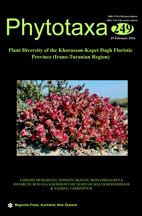Abstract
Oreosalsola, a non-C4 lineage is described as a new genus segregated from Salsola s.l. (Chenopodiaceae). The phylogenetic position and anatomical structure of the new genus in relation to photosynthetic types are discussed. Anabasis firouzii (Chenopodiaceae) and Salvia shahkuhmahalei (Lamiaceae) are described from Golestan National Park (GNP) and Ghorkhod Protected Area (GPA), NE Iran. The new Anabasis is a C4 plant according to its Salsoloid Kranz anatomy and carbon isotope composition. Anabasis firouzii grows on species-poor marl outcrops of Kopet Dagh Mountains in GNP and GPA. The phylogenetic relationship of the new species is discussed using ITS sequence data. The position of Anabasis setifera within the genus Anabasis (not Salsola) is confirmed by updated molecular data. Salvia shahkuhmahalei is closely related to S. rhytidea that is native of Afghanistan and S Iran. Salsola iljinii is transferred to Caroxylon following a new phylogenetic concept of Salsoleae. Seseli tortusosum subsp. kiabii (Apiaceae) is elevated to the species level, which is justified by the recent knowledge. The new species are illustrated; their habitat, plant communities, associated species, threat categories and phytogeographic importance are discussed.

